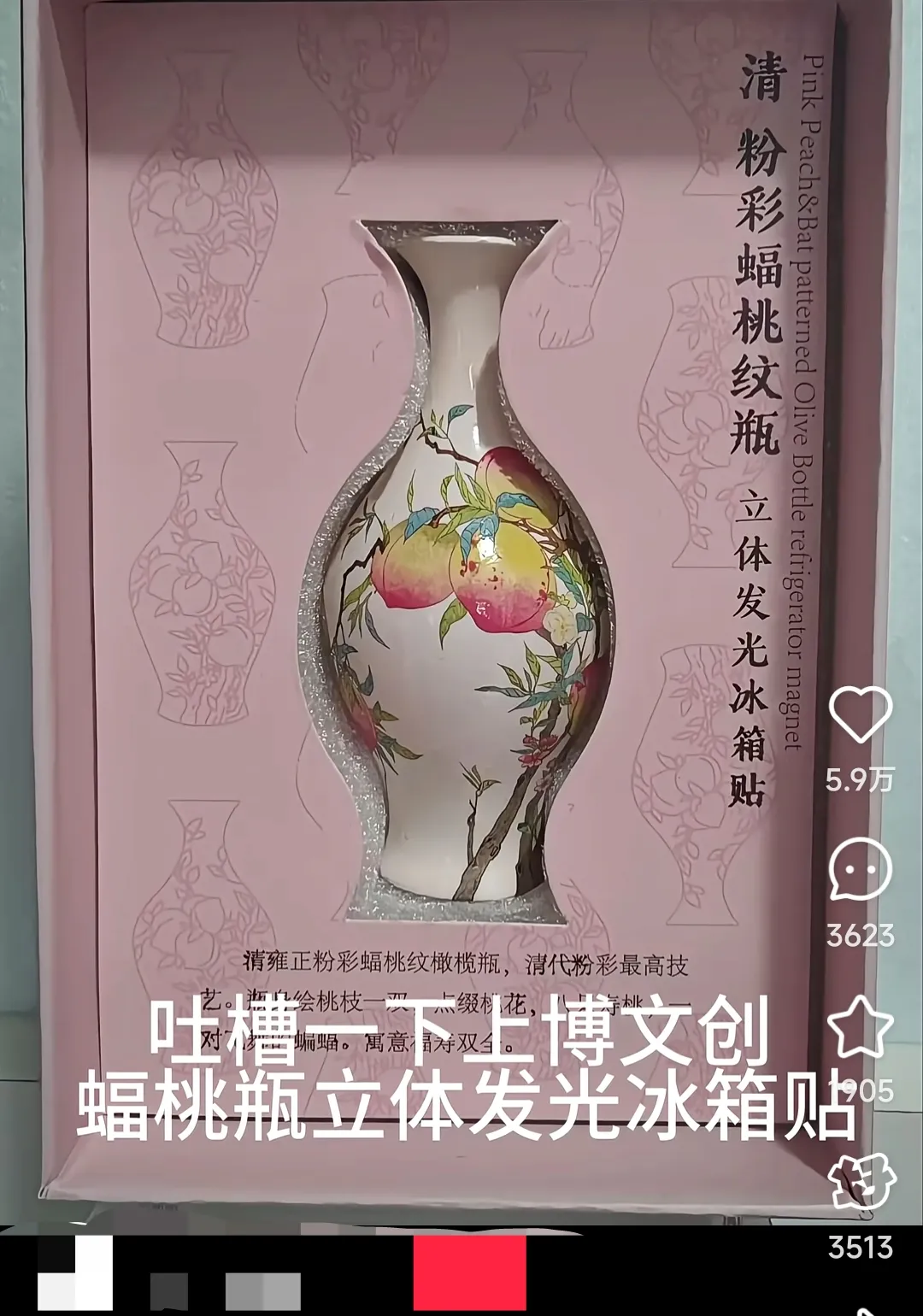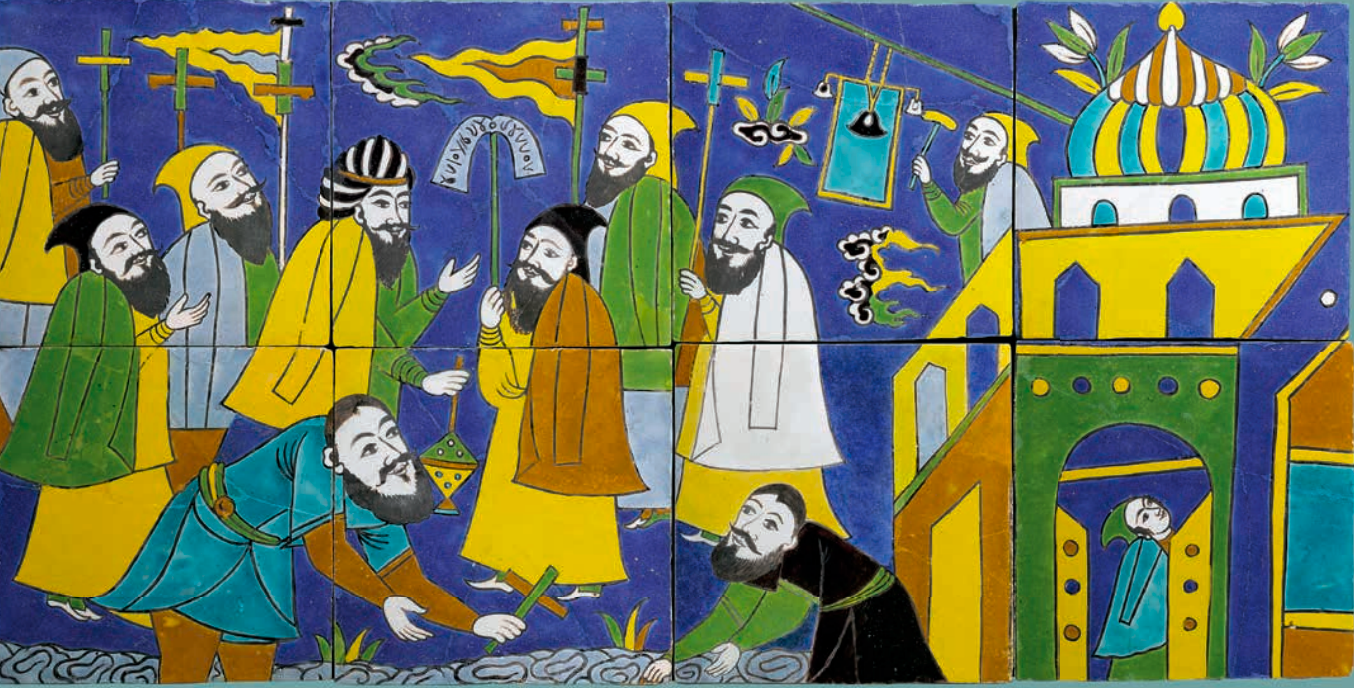
A "bat peach bottle" cultural and creative refrigerator magnet from the Shanghai Museum has recently sparked controversy. This luminous refrigerator magnet, based on the Qing Yongzheng famille rose olive bottle with bat peach pattern, has been accused of "consuming the history of suffering of cultural relics" because the cultural relic was once lost overseas and converted into a lamp holder and filled with sand and mud. The Shanghai Museum told The Paper this afternoon that since the bat peach bottle was collected by the Shanghai Museum in 2004, it has developed dozens of related cultural and creative products. "The luminous refrigerator magnet is just one of the cultural and creative products. The significance of the return of this cultural relic is diverse. The cultural and creative design of the bat peach bottle is not necessarily related to the history of humiliation." The Shanghai Museum has developed a variety of table lamp cultural and creative products based on ceramic cultural relics, and made the same table lamp as the Yaozhou Kiln more than 30 years ago.
A senior cultural and museum scholar told The Paper that as a public institution based on research, museums should not avoid the pain of cultural relics, nor embellish their past experiences. The museum's professional right of interpretation should not give way to emotional interpretations.
In fact, this controversy, ostensibly an aesthetic criticism of a cultural and creative product, actually touches upon the role of museums in modern society, the right to interpret history, and the eternal tension between national sentiment and historical objectivity.
Netizens say the design of the "bat peach bottle" makes them uncomfortable
On July 7, a netizen posted that he had bought a "bat peach bottle" refrigerator magnet in the cultural and creative area of the East Hall of the Shanghai Museum. The netizen said that the "luminous function" and "bottom hole" design of this refrigerator magnet formed an uncomfortable echo with the experience of the bat peach bottle being lost overseas. After the media reported this netizen's personal "complaint", it caused greater controversy. Is it necessary to amplify this one-sided interpretation based on personal subjective experience? And what do industry insiders think of the development of this cultural and creative product?

Netizens questioned the Shanghai Museum Cultural and Creative Bat and Peach Bottle 3D Luminous Fridge Magnet for "disrespecting history". Source: Social Media
The Qing Dynasty Yongzheng famille rose olive vase with bat and peach pattern is a porcelain treasure collected by the Shanghai Museum. It has a lipped mouth, long neck, sloping shoulders, bulging belly and ring foot. It is shaped like an olive, so it is also called an olive vase. The body of the vase is painted with eight peaches and two bats in famille rose, because peaches symbolize "longevity" and bats are the homophone of "happiness", which means both happiness and longevity.
In the first half of the 20th century, the bat-peach vase was lost overseas and for decades, it had been used as a lamp holder without any protection. It was later discovered by an auction company and in 2002, Hong Kong collector Dr. Zhang Yongzhen won the vase at a high price of HK$41.5 million and donated it to the Shanghai Museum in 2004.
The value of the Bat-Peach Vase has multiple aspects. For example, it is an innovative work of the Yongzheng official kiln (the first time that flat bat-peach patterns were applied to a three-dimensional porcelain vase), a demonstration of the Qing Dynasty's famille rose craft, and a microcosm of the history of Chinese and Western collections and a symbol of the return of cultural relics.

Qing Yongzheng famille rose olive vase with bat and peach pattern. Image source: Shanghai Museum official website
A search by The Paper found that the Shanghai Museum has developed many styles of cultural and creative products based on the "Qing Yongzheng Peach-patterned Olive Bottle" in its collection, with a clear tolerance for multiple narratives. There is not only this controversial luminous "Bat and Peach Bottle" refrigerator magnet cultural and creative product, but also small ornaments imitating the "Bat and Peach Bottle", resin three-dimensional refrigerator magnets, etc., all of which are popular with the audience because of their small size, exquisiteness and fine workmanship.

The Shanghai Museum has developed a variety of cultural and creative products based on the "Qing Yongzheng Famille Rose Olive Bottle with Bat and Peach Pattern" in its collection, not just the luminous refrigerator magnet.
The Shanghai Museum told The Paper | Ancient Art this afternoon, "In fact, Europeans and Americans have a long history of loving Chinese porcelain. They also like to use Chinese porcelain for some secondary use and artistic processing to decorate their lives. This was a very popular trend at the time. The Shanghai Museum has developed many kinds of table lamps using ceramic cultural relics. More than 30 years ago, it made Yaozhou kiln table lamps. The Shanghai Museum's cultural and creative concept is to make life artistic and art life-like . This year, refrigerator magnets have become popular because they are inexpensive and can decorate life."

The Shanghai Museum has developed many cultural and creative products based on the olive bottle with bat and peach pattern
The museum's professional interpretation rights should not give way to individual one-sided interpretations
"Netizens have over-interpreted the meaning of the Shanghai Museum's cultural and creative product." After the controversy, some people commented that "cultural and creative development should not ridicule painful history." A senior practitioner in the cultural and creative field told The Paper, "Yesterday, everyone in our industry paid attention to this matter and discussed it. In the eyes of us insiders, this is more of a one-sided interpretation based on personal cognition by netizens. This argument needs to be discussed."
"First of all, I believe that museums have the right to interpret the cultural creations they develop and the cultural relics they collect; secondly, we should have a correct view of the past of cultural relics and their experiences in specific historical periods." The industry insider said, "Different cultures first have integration, and cultural relics also have their own past, present and future. The public can look at the history of cultural relics more objectively."
Some media researchers also said that the one-sided emotions of netizens were amplified by some media, and the inclusion of "equivalent to using opium to commemorate Lin Zexu" in the title is really questionable.
A senior cultural scholar told The Paper that when the Shanghai Museum's "Bat-Peach Bottle" cultural creation caused a public opinion storm due to design details, the analogy of "using opium to commemorate Lin Zexu" pushed a serious and professional museum to the national sentiment trial. In this controversy, a core proposition has become increasingly clear: as a public institution based on research, the museum's professional right of interpretation should not give way to extreme emotional interpretations, nor should it be coerced by one-sided nationalist narratives. "The core mission of the museum's cultural and creative products is to integrate dusty history into contemporary life through creative transformation. The museum is not an ordinary cultural commodity supplier. Its authority is rooted in professional cornerstones such as the systematic nature of academic research, the ability to restore historical contexts, and the identification system of cultural values."
"It is logically absurd to compare this cultural product to the relationship between Lin Zexu and opium." A cultural and museum practitioner with the Weibo name "VCeley Ylang" believes that "as a public institution with cultural relics research as its background, it is normal for the museum to present any real historical information of the collection." "Stepping back, the museum can even really make a replica of a porcelain vase in the shape of a table lamp and sell it to clearly tell the public: this cultural relic has been misappropriated."
Professor Liu Zhaohui from the Department of Cultural Relics and Museology at Fudan University said that the use and modification of Chinese porcelain overseas has a long tradition. "In the Middle East, Chinese porcelain is inlaid with gems and becomes a treasure. In Europe, Chinese porcelain, as a favorite of the nobility, is also redecorated and modified locally according to local aesthetic trends and life needs. This phenomenon is quite popular. For example, metal inlays are added to protect fragile materials to adapt to local usage habits, or the decorativeness of accessories is used to make it echo the European interior decoration style. Similarly, China will modify Western objects to adapt to local needs. For example, the Qing Palace modified and used European enamel and Japanese lacquerware."

Bowl with blue and white alum red and gold lotus pattern inlaid with gilded silver base. Porcelain from Jingdezhen kiln, China, about 1583, inlaid with German. Collection of the Victoria and Albert Museum, UK
Shan Jixiang, former director of the Palace Museum, once said: "Cultural relic restoration is not about erasing historical traces, but about allowing cultural layers of different eras to communicate." The Shanghai Museum's official website records the complete circulation process of the bat-peach bottle - "It was once scattered overseas for a long time, and was once converted into a lamp holder, and the bottle was filled with sand and mud." This statement is based on rigorous archival research. It represents the respect of professional institutions for history: they do not avoid pain, do not embellish past experiences, and do not tamper with physical evidence due to pressure from the times.


